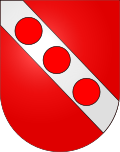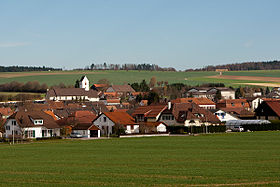All JU
| JU is the abbreviation for the canton of Jura in Switzerland and is used to avoid confusion with other entries of the name Alle . |
| All | |
|---|---|
| State : |
|
| Canton : |
|
| District : | Porrentruy |
| BFS no. : | 6771 |
| Postal code : | 2942 |
| Coordinates : | 576 757 / 253 043 |
| Height : | 450 m above sea level M. |
| Height range : | 437-529 m above sea level M. |
| Area : | 10.60 km² |
| Residents: | 1850 (December 31, 2018) |
| Population density : | 175 inhabitants per km² |
| Website: | www.alle.ch |
|
All |
|
| Location of the municipality | |
Alle ( fc. [ (Æ) aːl ], dt. Obsolete Hall ) is a municipality in the district of Porrentruy in the canton of Jura in Switzerland .
geography
All lies at 450 m above sea level. M. , 4 km east of the district capital Porrentruy (air line). The clustered village extends in the wide valley of the Allaine river in the Ajoie (German Elsgau ) at the northern foot of the Jura .
The area of the 10.6 km² large municipal area includes the slightly undulating table Jura landscape of the Ajoie in the northern section and reaches Gros Bois at 530 m above sea level in the forest . M. the highest elevation in the community. The slope, sloping slightly to the south, gradually merges into the lowlands of the Allaine and the Cornol stream, which flows from the south. The wooded dry valley Combe Vaumacon forms the western boundary . In 1997, 13% of the municipal area was in settlements, 21% in forests and woodlands, 65% in agriculture and a little less than 1% was unproductive land.
Several individual farms belong to all. Neighboring municipalities to Alle are Cornol , Courgenay , Porrentruy , Coeuve , Vendlincourt and La Baroche .
population
With 1,850 inhabitants (as of December 31, 2018), Alle is one of the larger municipalities in the canton of Jura. 93.1% of the residents are French-speaking, 2.9% Italian-speaking and 1.6% German-speaking (as of 2000). The population of Alle peaked around 1970. The economic crisis during the 1970s saw a significant decline.
economy
| Population development | |
|---|---|
| year | Residents |
| 1850 | 918 |
| 1900 | 1,238 |
| 1910 | 1,122 |
| 1930 | 1,209 |
| 1950 | 1,371 |
| 1960 | 1,471 |
| 1970 | 1,615 |
| 1980 | 1,501 |
| 1990 | 1,464 |
| 2000 | 1,542 |
The community was dominated by agriculture until the end of the 19th century . After that, industrialization began in the village ; Wood and watchmaking companies settled here, but a tricot factory and a worsted spinning mill are also of regional importance. Nevertheless, agriculture still has its place today thanks to the fertile and easily workable soils. In 1964 a central point for grain collection and drying was set up in Alle; it belongs to the Center-Ajoie agricultural cooperative. The Fête des paysans jurassiens (Jurassic farmers' festival) has been celebrated in Alle every year since 1975 . The renovated buildings of a disused factory have housed the cantonal armory since 1984 .
traffic
The community has good transport links. It is located on the regional road from Porrentruy via Lucelle to Laufen . The section of the A16 motorway from Delémont to Porrentruy, which was opened in 1998 and is to be connected to both the Swiss national road network and the French motorway network by 2015, runs through the southern municipal area . The nearest motorway connections are Courgenay in the south and Porrentruy-Est in the west. On July 14, 1901, the Porrentruy – Bonfol line of the Chemins de fer du Jura was opened with a train station in Alle. The Porrentruy - Lucelle post bus line also runs through the village.
history
The municipality of Alle can look back on a very long tradition of settlement. Archaeological excavations in the Noire Bois forest in the south-west of Alle have unearthed finds from settlements that were inhabited around 2300 BC and during the La Tène period (around 400 BC). In Roman times an important road ran through Alle.
The place is first mentioned in 1136 as Alla ; the name corresponds to that of the river Allaine , which joins from several source brooks just outside the village , which in German was formerly also called Hall . In 1271 the place came to the duchy of Basel for the first time and subsequently shared the fate of the Ajoie. In the 16th century, Alle became the capital of one of the five dairy farms in the Ajoie. The village was badly affected in the Thirty Years War . From 1730 to 1740 it was the meeting place for the farmers who repeatedly revolted against the authorities. From 1793 to 1815 Alle belonged to France and was initially part of the Département du Mont-Terrible , from 1800 connected to the Département Haut-Rhin . By decision of the Congress of Vienna , the place came to the canton of Bern in 1815 and on January 1, 1979 to the newly founded canton of Jura.
Attractions
The village church of Saint-Jean-Baptiste with a late medieval bell tower stands at a slightly elevated point. This was retained during the renovation in 1951-53. Typical rows of houses from the 18th and 19th centuries have been preserved along the Allaine and Cornol brooks.
photos
Roland Béguelin Monument
Web links
- Official website of the municipality of Alle
- François Schifferdecker, François Kohler: All. In: Historical Lexicon of Switzerland .
Individual evidence
- ↑ Permanent and non-permanent resident population by year, canton, district, municipality, population type and gender (permanent resident population). In: bfs. admin.ch . Federal Statistical Office (FSO), August 31, 2019, accessed on December 22, 2019 .
- ↑ a b Florence Cattin, Alle JU (Porrentruy) in: Dictionnaire toponymique des communes suisses - Lexicon of Swiss community names - Dizionario toponomastico dei comuni svizzeri (DTS | LSG) , Center de dialectologie, Université de Neuchâtel, Verlag Huber, Frauenfeld / Stuttgart / Vienna 2005, ISBN 3-7193-1308-5 and Éditions Payot, Lausanne 2005, ISBN 2-601-03336-3 , p. 82.










